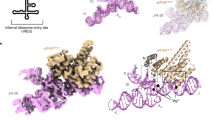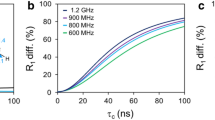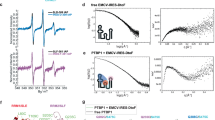Abstract
NMR magnetization transfer from water and ammonia-catalyzed exchange of the imino proton have been used to probe enhanced thermostability and conformational rearrangements induced by Mg2 + in two key activity fragments r(CACCUGGCGACAGGUG) and r(GGCCAAAAGCC) of the encephalomyocarditis virus (EMCV) picornavirus internal ribosome entry site (IRES). We have measured some of their r(G·C) base-pair lifetimes and dissociation constants under different MgCl2 conditions, and we compare them with those of other short RNA duplexes. The RNA fragment r(CACCUGGCGACAGGUG) adopts two topologies, a palindromic duplex with two conformations and a hairpin, whose equilibrium can be monitored: the duplex form is destabilized by Mg2 + and temperature, a delicate balance wherein the entropic contribution of the free energy helps populate the hairpin state. For both fragments, the opening rates of the r(G·C) pairs are lower in the presence of Mg2 + and their dissociation constants are smaller or comparable. Analysis of the results suggests that Mg2 + has a preferential and specific effect on the r(CACCUGGCGACAGGUG) hairpin in the region close to the r(G·C) closing pair of the GCGA tetraloop, and the ion moves diffusively around r(GGCCAAAAGCC), thereby differentiating the GNRA and RAAA hairpin motifs that are both involved in the biological regulation functions of the EMCV IRES.






Similar content being viewed by others
References
Van Der Velden, A., Kaminski, A., Jackson, R., Belsham, G.: Defective point mutants of the encephalomyocarditis virus internal ribosome entry site can be complemented in trans. Virology 214, 82–90 (1995). doi:10.1006/viro.1995.9952
Hoffman, M.A., Palmenberg, A.C.: Mutational analysis of the J-K stem-loop region of the encephalomyocarditis virus IRES. J. Virol. 69, 4399–4406 (1995)
Witherell, G.W., Schultz-Witherell, C.S., Wimmer, E.: Cis-acting elements of the encephalomyocarditis virus internal ribosomal entry site. Virology 214, 660–663 (1995). doi:10.1006/viro.1995.0081
Roberts, L.O., Belsham, G.: Complementation of defective picornavirus internal ribosome entry site (IRES) elements by the co-expression of fragments of the IRES. Virology 227, 53–62 (1997). doi:10.1006/viro.1996.8312
Kolupaeva, V., Pestova, T., Hellen, C., Shatsky, I.: Translation eukaryotic initiation factor 4G recognizes a specific structural element within the internal ribosome entry site of encephalomyocarditis virus RNA. J. Biol. Chem. 273, 18599–18604 (1998). doi:10.1074/jbc.273.29.18599
Robertson, M., Seamons, R., Belsham, G.: A selection system for functional internal ribosome entry site (IRES) elements: analysis of the requirement for a conserved GNRA tetraloop in the encephalomyocarditis virus IRES. RNA 5, 1167–1179 (1999). doi:10.1017/S1355838299990301
Fernandez-Miragall, O., Ramos, R., Ramajo, J., Martinez-Salas, E.: Evidence of reciprocal tertiary interactions between conserved motifs involved in organizing RNA structure essential for internal initiation of translation. RNA 12, 223–234 (2006). doi:10.1261/rna.2153206
Phelan, M., Banks, R.J., Conn, G., Ramesh, V.: NMR studies of the structure and Mg2 + binding properties of a conserved RNA motif of EMCV picornavirus IRES element. Nucleic Acids Res. 32, 4715–4724 (2004). doi:10.1093/nar/gkh805
Snoussi, K., Leroy, J.-L.: Alteration of AT base-pair opening kinetics by the ammonium cation in DNA A-tracts. Biochemistry 41, 12467–12474 (2002). doi:10.1021/bi020184p
Snoussi, K., Leroy, J.-L.: Imino proton exchange and base-pair kinetics in RNA duplexes. Biochemistry 40, 8898–8904 (2001). doi:10.1021/bi010385d
Leroy, J.-L., Charretier, E., Kochoyan, M., Guéron, M.: Evidence from base-pair kinetics for two types of adenine tract structures in solution: their relation to DNA curvature. Biochemistry 27, 8894–8898 (1988). doi:10.1021/bi00425a004
Kochoyan, M., Leroy, J.-L., Guéron, M.: Processes of base-pair opening and proton exchange in Z-DNA. Biochemistry 29, 4799–4805 (1990). doi:10.1021/bi00472a008
Guéron, M., Leroy, J.-L.: Studies of base pair kinetics by NMR measurement of proton exchange. Methods Enzymol. 261, 383–413 (1995). doi:10.1016/S0076-6879(95)61018-9
Cantor, C.R., Warshaw, M.M., Shapiro, H.: Oligonucleotide interactions. III. Circular dichroism studies of the conformation of deoxyoligonucleotides. Biopolymers 9, 1059–1077 (1970). doi:10.1002/bip.1970.360090909
Jucker, F.M., Heus, H.A., Yip, P.F., Moors, E.H.M., Pardi, A.: A network of heterogeneous hydrogen bonds in GNRA tetraloops. J. Mol. Biol. 264, 968–980 (1996). doi:10.1006/jmbi.1996.0690
Searle, M.S., William, D.H.: On the stability of nucleic acid structures in solution: enthalpy–entropy compensations, internal rotations and reversibility. Nucleic Acids Res. 21, 2051–2056 (1993). doi:10.1093/nar/21.9.2051
Hermann, T., Westhof, E.: Exploration of metal binding sites in RNA folds by Brownian-dynamics simulations. Structure 6, 1303–1314 (1998). doi:10.1016/S0969-2126(98)00130-0
Uhlenbeck, O.C.: Nucleic-acid structure tetraloops and RNA folding. Nature 20, 613–614 (1990). doi:10.1038/346613a0
Antao, V.P., Tinoco, I., Jr.: Thermodynamic parameters for loop formation in RNA and DNA hairpin tetraloops. Nucleic Acids Res. 20, 819–824 (1992). doi:10.1093/nar/20.4.819
Saenger, W.: Principles of Nucleic Acid Structure. Springer, New York (1984)
Russell, R., Zhuang, X., Babcock, H.P., Millett, I.S., Doniach, S., Chu, S., Herschlag, D.: Channels in the folding landscape. Proc. Natl. Acad. Sci. U. S. A. 99, 155–160 (2002). doi:10.1073/pnas.221593598
Acknowledgements
Julien A. Dupont is a studentship recipient of the F.R.I.A. (Fonds pour la formation à la Recherche dans l’Industrie et l’Agriculture). This work was supported by the Belgian National Foundation for the Scientific Research (F.N.R.S.) and the Catholic University of Louvain (Fonds Spéciaux de Recherche).
Author information
Authors and Affiliations
Corresponding author
Rights and permissions
About this article
Cite this article
Dupont, J.A., Snoussi, K. Mg2+ modulation of EMCV IRES key activity fragment equilibria and r(G·C) base-pair kinetics. J Biol Phys 35, 231–243 (2009). https://doi.org/10.1007/s10867-009-9151-2
Received:
Accepted:
Published:
Issue Date:
DOI: https://doi.org/10.1007/s10867-009-9151-2




